#LoretoIdeal Campaign Calls on Citizens to Shape Loreto’s Future

On June 19, Loreto had its first taste of a long-term campaign to promote truly participative democracy in the municipality, involving citizens, businesses/organizations, and government. The #LoretoIdeal collaboration already has 14 local and regional groups formally committed – with organizations, citizens, and candidates pledging to help address Loreto’s major problems in a transparent, inclusive, and solution-focused way.
Eco-Alianza worked to initiate the #LoretoIdeal campaign, in collaboration with the NGOs Alcosta, Fundar, and Centro de Colaboración Cívica (CCC). The process began with a presentation to the municipal government in October of last year, followed by focus group meetings with local organizations in March, more organizational workshops this spring, and an official meeting of group representatives on June 21. Additional groups are still joining the alliance.
The broad coalition of local groups already taking part includes the local university (UABCS), the chamber of commerce, restaurant and hotel associations, fishermen and nature guides, teachers, Eco-Alianza, other NGOs and, in the words of one participant, “all kinds of groups and people who have a common interest in making Loreto work for everyone.” Now that the campaign is underway, no one group will be “in charge,” of the coalition’s activities, and the leadership roles will rotate and be shared equally.
Following the July 1 elections, a series of “deliberative forums” will explore what participants see as the most critical issues facing the municipality. The group will work toward positive actions in concert with the new municipal administration, around the themes of making Loreto clean, sustainable, tranquil, safe, transparent, and participative. A main objective is to improve the implementation of guiding documents that Eco-Alianza has been instrumental in helping to enact – the ecological ordinance (POEL), the urban development plan, and the solid waste plan.
To that end, #LoretoIdeal allies’ members have met with all seven mayoral candidates and helped to inform them about many details of priority issues. No matter who wins the July 1 election, #LoretoIdeal allied organizations will be working alongside local government, Loreto organizations and groups, and local citizens to address these issues.
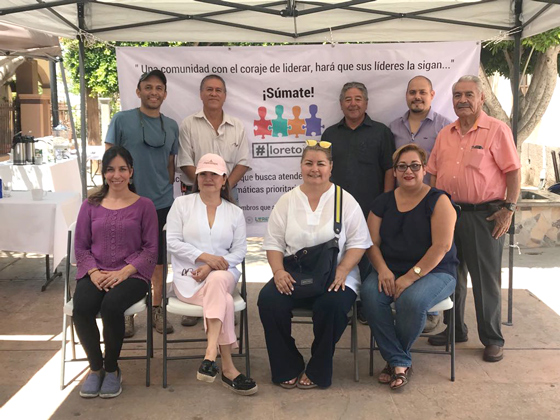
Photo courtesy of #LoretoIdeal
The newly-formed coalition of organizations on June 25 held an open event on the town plaza at which all seven mayoral candidates, and candidates for other offices, signed letters pledging to work in cooperation with #LoretoIdeal. Nine of the 14 organizations that are part of the #LoretoIdeal coalition were represented at the event, chatting with the candidates as well as interested citizens.
To date, there are 14 associations that have joined #LoretoIdeal:
![]() Madrugadores de Loreto A.C.
Madrugadores de Loreto A.C.
![]() CANIRAC
CANIRAC
![]() CANACO Loreto
CANACO Loreto
![]() Colegio de Arquitectos de B.C.S.
Colegio de Arquitectos de B.C.S.
![]() Colegio de Ingenieros Civiles de B.C.S. sección Loreto
Colegio de Ingenieros Civiles de B.C.S. sección Loreto
![]() Colegio de Médicos de B.C.S.
Colegio de Médicos de B.C.S.
![]() UABCS
UABCS
![]() Raíces Vivas A.C.
Raíces Vivas A.C.
![]() CEMDA
CEMDA
![]() Red de Educadores Ambientales de Loreto
Red de Educadores Ambientales de Loreto
![]() Eco-Alianza de Loreto, A.C.
Eco-Alianza de Loreto, A.C.
![]() Isla Verde
Isla Verde
![]() Onco Loreto, A.C.
Onco Loreto, A.C.
![]() Asociación de Hoteles de Loreto, A.C.
Asociación de Hoteles de Loreto, A.C.
Eco-Alianza Executive President Hugo Quintero points out that “this type of approach is what facilitated the passage of the POEL and other important guiding documents,” and expresses thanks to all the groups and individuals who are already involved with #LoretoIdeal, as well as to those who lend a hand in the future.
For more information on #LoretoIdeal, visit the website: https://www.loretoideal.org .
![]()
Your Plastic Bottletops Can Help Children With Cancer
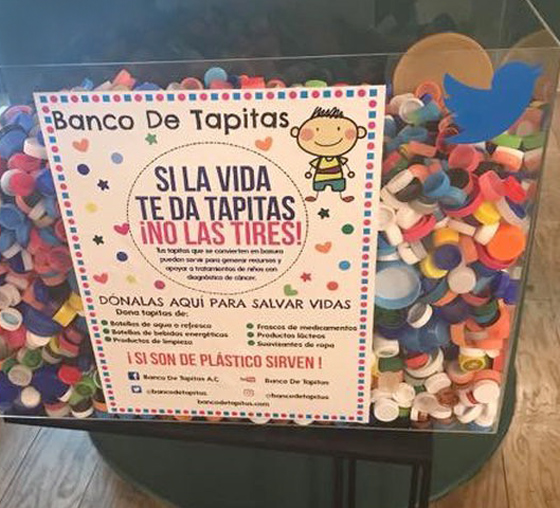
Since May 10, Eco-Alianza has been registered as an official Ambassador and collection point for the national “Banco de Tapitas” campaign. The Mexico City NGO operates a national plastic bottletop collection operation that supports children with cancer.
Here’s how it works. You collect your plastic bottletops until you are ready to bring them in. Deposit them in the container in Eco-Alianza’s lobby any weekday morning, from 9 a.m. until noon. When we have a certain amount, they are picked up at no cost and taken to a recycling facility and sold. The money goes to help Mexican children who suffer from all types of childhood cancer (more details on the BancodeTapitas.org website or visit their Facebook page).
In addition to keeping bottletops out of the ocean and off of our beaches, separating the bottletops is beneficial to plastic bottle recycling efforts because the caps are generally made of a different kind of plastic than the bottles. By removing them it improves the purity and hence the value of plastic bottle recycling.
Banco de Tapitas, AC has support from several national businesses, including a delivery service, which apparently donates the pickup and delivery of the containers filled with bottletops. Some of the Banco de Tapitas supporting businesses also offer discount coupons for other services through the Banco de Tapitas website.
So please join us – thanks for removing your plastic bottletops and pitching in to help the environment and to help children with cancer and the same time!
For more information: BancodeTapitas.org
![]()
Dr. Wallace J. Nichols to Speak His
Blue Mind at Eco-Alianza Saturday, July 7
5 – 7 p.m.
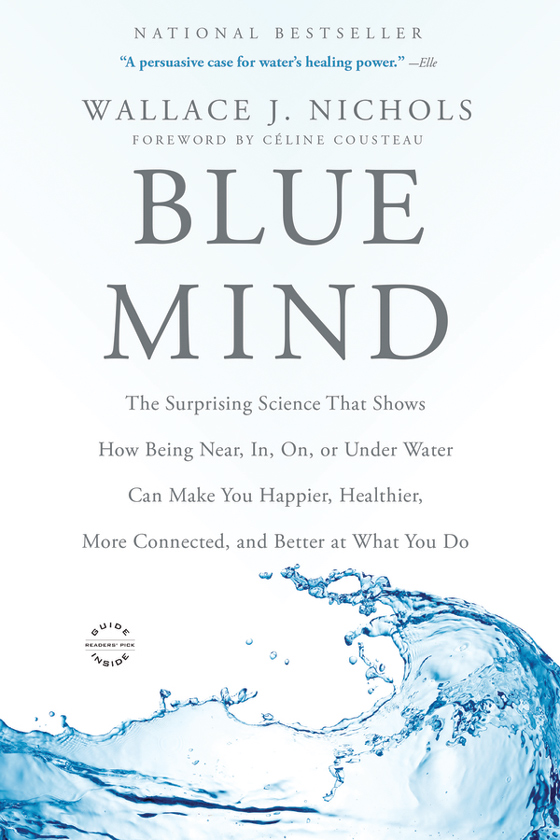
Next up in Eco-Alianza’s Visiting Scientist series is best-selling author Wallace J. Nichols, speaking about “Blue Mind” on Saturday, July 7 from 5 to 7 p.m. at our CenCoMA headquarters on Calle Hidalgo. Dr. Nichols is a marine biologist, activist, community organizer, and author who works to inspire a deeper connection with nature.
Blue Mind combines cutting-edge research with compelling personal stories about the remarkable benefits of being in, on, under, or simply near water. Dr. Nichols will discuss how proximity to water can improve performance, increase calm, diminish anxiety, and increase professional success. Blue Mind not only illustrates the crucial importance of our connection to water, it provides a practical blueprint for a better life.

Dr. Nichols has been called “Keeper of the Sea” by GQ Magazine and “a visionary” by Outside Magazine. Formerly a Senior Scientist at Ocean Conservancy, Dr. Nichols has authored more than 200 scientific papers, and publications. He has also lectured in more than 30 countries and will present at Eco-Alianza in Spanish. He is bilingual, so the presentation will be followed by questions and answers in both Spanish and English.
The presentation is free and open to the public. For more information, visit wallacejnichols.org .
![]()
Eco-Alianza Celebrates World Oceans Day with Recyclathon Winners
and a Plastic-Free Ocean Presentation
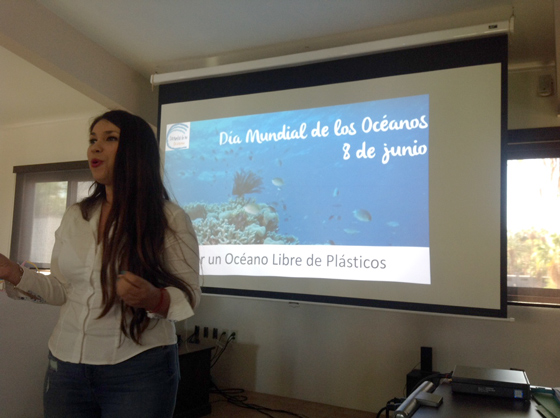
Eco-Alianza staff photo
Edna Peralta presents facts about ocean plastics.
World Oceans Day, June 8, is always a special day at Eco-Alianza. This year we celebrated with a packed house of enthusiastic recyclers and other supporters when announcing the winners of the fifth annual Recyclathon. The three-month competition included 14 4-person teams, who collectively recycled nearly 25,000 pounds of plastic, cardboard, paper, and glass, setting a new Recyclathon record!
Prior to the awards ceremonies, participants were treated to a slide presentation by Environmental Education Coordinator Edna Peralta, titled “For an Ocean Free of Plastics.” The presentation was informative, entertaining, and left listeners with several encouraging action steps to help free the world’s oceans from the scourge of plastic pollution.
Edna was talking with a supportive and enthusiastic audience of participants, because most of the attendees were team members in the Recyclathon, a major point of which is to keep plastics out of the landfill and out of the marine park. During March, April, and May, the 14 teams recycled:
6 tons and 321.5 kg of plastics
3 tons and 877.5 kg of cardboard
1 ton and 687.5 kg of glass
547 kg of office paper
The top 10 teams completing the Recyclathon will receive trips to the islands in the national marine park, and the rest received various recognitions and prizes. Thanks again to the sponsors of this year’s Recyclathon:
![]() Three teams will visit Isla Danzante on the glass bottom boat, donated by Tim and Ciria Yarbrough from Loreto Coastal Expeditions. https://www.wantosea.com
Three teams will visit Isla Danzante on the glass bottom boat, donated by Tim and Ciria Yarbrough from Loreto Coastal Expeditions. https://www.wantosea.com
![]() Four teams will visit Isla Danzante on the catamaran donated by Justin Benham from Wild Loreto Tours. https://www.wildloreto.com
Four teams will visit Isla Danzante on the catamaran donated by Justin Benham from Wild Loreto Tours. https://www.wildloreto.com
![]() Three teams will visit Isla Coronados, facilitated by Eco-Alianza and its donors and Parque Nacional Bahía de Loreto.
Three teams will visit Isla Coronados, facilitated by Eco-Alianza and its donors and Parque Nacional Bahía de Loreto.
Congratulations to all the participating teams and their supporters! In the competition for prizes, each kilogram of paper, cardboard and glass was worth one point and each kilogram of plastic was worth 10 points. Here are the top three teams, with awards presented by Edna Peralta and sponsors Ciria and Tim Yarbrough:
First place: 29,943 points
Team Galapago Tamaulipeco
Cindia Romero Arce
Daniel Leal Gonzalez
Heydi Murillo Romero
Mariana Romero
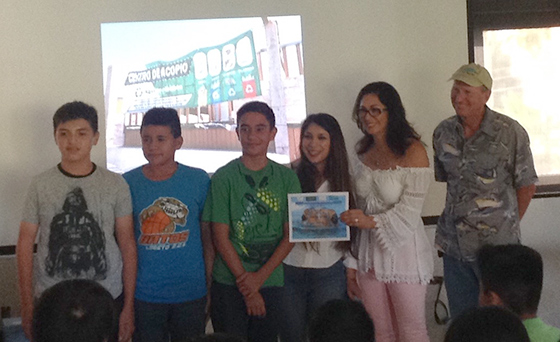
Eco-Alianza staff photo First place winners!
Second Place: 23,925 points
Team Tortuga Lagarto
Joana Cristina Reyes Bastida
Jesus Ricardo Murillo Reyes
Dylan Ruben Murillo Murillo
María Elsa Murillo Naranjo
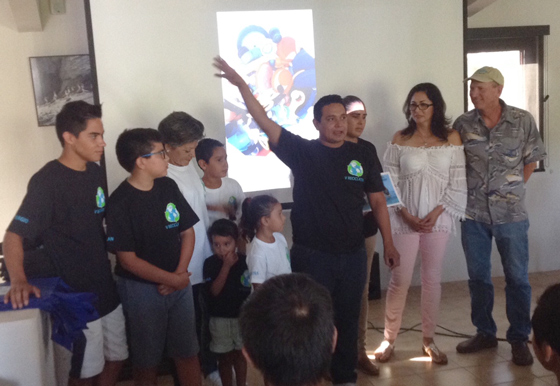
Eco-Alianza staff photo
Second place winners.
Third Place: 2,540 points
Team Geko Plano
Eduan Alejo Davis Ramirez
José Luis González Sotelo
Raziel Rubio León
José Ventura González Murillo

Eco-Alianza staff photo
Third place winners.
It is worth mentioning that although the Recyclathon culminated after three months, plastics, office paper, cardboard and glass are still gratefully accepted at the recycling transfer station located on transpeninsular highway km3. We invite all of you to participate by donating these materials to ensure that the waste is recycled instead of going to the dump or the sea. If you have questions, you can contact Cesar Días for details: Cell phone: 646 179 7628.
![]()
Blue Whale Expert Dr. Diane Gendron
Has Good News and Bad News
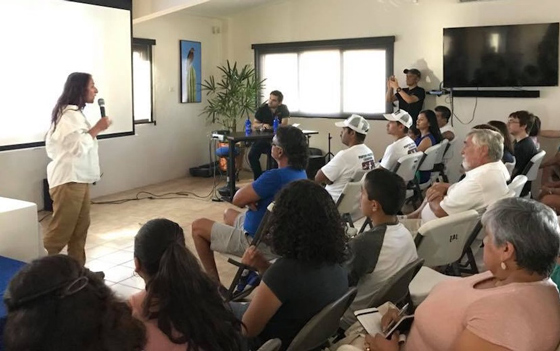
Eco-Alianza staff photo
Dr. Diane Gendron
June began with a fast start at Eco-Alianza, with a fascinating standing-room-only Visiting Scientist presentation by world-renowned Blue Whale expert Dr. Diane Gendron.
Prior to Diane’s presentation, the CenCoMA audience enjoyed a presentation by Lizette Inzunza, president of Loreto’s Sister City committee, and by Caryl Cantrell, the visiting chairperson of the Sister City committee in Ventura, California. Lizette talked about the cultural exchange between Loreto and Ventura, and the purpose of the Sister Cities program. Caryl presented slides and stories about the devastating fires in Ventura, and hopeful signs of recovery in the aftermath.
Dr. Diane Gendron drew the connection between the Loreto/Ventura Sister Cities/Sister Parks programs and her more than 20 years of Blue Whale research, saying that without protected areas and safe waters all along the migration route of the Blue Whales, they would be in more serious trouble as a species than they already are. Many Blue Whales migrate through our Sister Park, the Channel Islands National Park, on their way south, ultimately winding up here in the Bay of Loreto National Park.
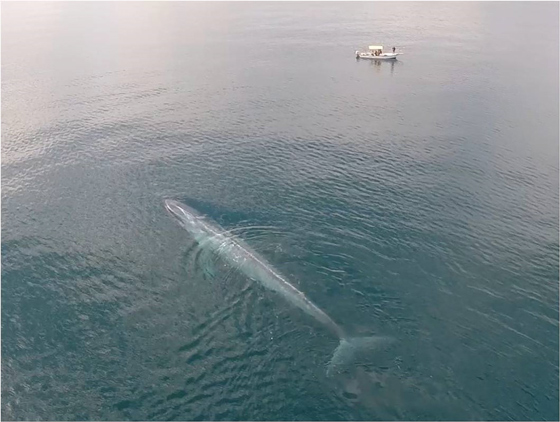
Photo courtesy of Dr. Diane Gendron
Blue Whale dwarfs human observers
Dr. Gendron has studied the whales here and elsewhere with a variety of techniques, including satellite tracking, remote cameras, and temporary tagging to glean information about their underwater activities. She and her team have been instrumental in developing the technique of “passive whale watching,” in which scientists and other whale observers turn off their boat motors when in the presence of Blue Whales, instead of essentially chasing them, as had been done in the past.
The technique has resulted in far less stress on the animals, and far more viewing opportunity for observers. The whales stay near the surface much longer and dive much shallower when boat motors are turned off, and often swim in a large arc or even a circle around the boats. These discoveries are chronicled in a 9-minute film by CONANP, available for viewing here: http://www.batyoutube.com/watch?v=vJxaU3THLQY
Unfortunately, while the success of passive whale watching techniques is the good news, Dr. Gendron said, there is also bad news. Over the last few years especially, she and other Blue Whale researchers worldwide have begun observing an alarming number of very thin adult Blue Whales. She showed several photos of whales whose spines were quite prominent, which is not normally the case. She said she could point to several possible causes, some natural, some human-caused, but pointed out that speculation is just that, and that more real science is needed to study this.
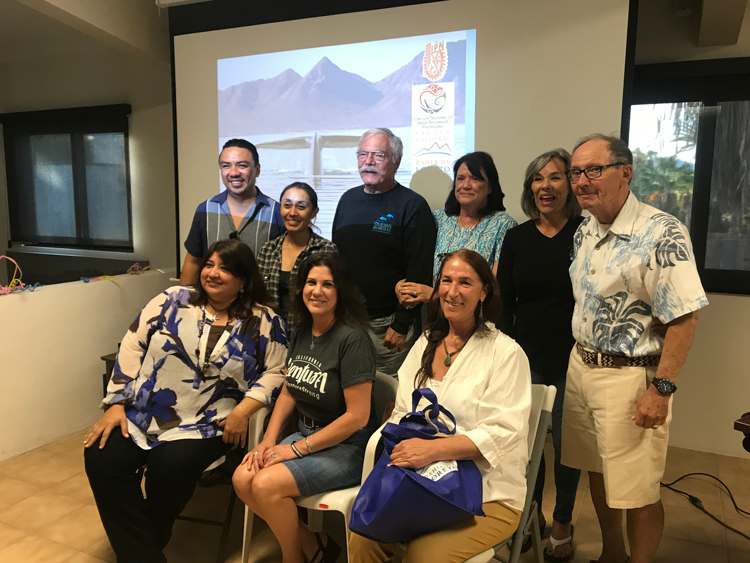
Eco-Alianza staff photo
Front row, left to right: Lizette Inzunza, Caryl Cantrell, Dr. Diane Gendron. Back row, left to right: Park Director Israel Popoca, Park Biologist Mariana Salgado, Visiting Scientist sponsors Charles and Kathryn Mitchell, Linda and Anthony Kinninger.
Ending on a positive note, Dr. Gendron thanked the audience for their interest in Blue Whales and in marine conservation. Without concerned people, and marine protected areas, she said, many marine species would be in more trouble than they are.
And while she conceded that humans are the only cause of the terrible problem of plastic pollution, they also are the most likely species to solve it.
![]()
“Tuqan Man” Returned to San Miguel Island
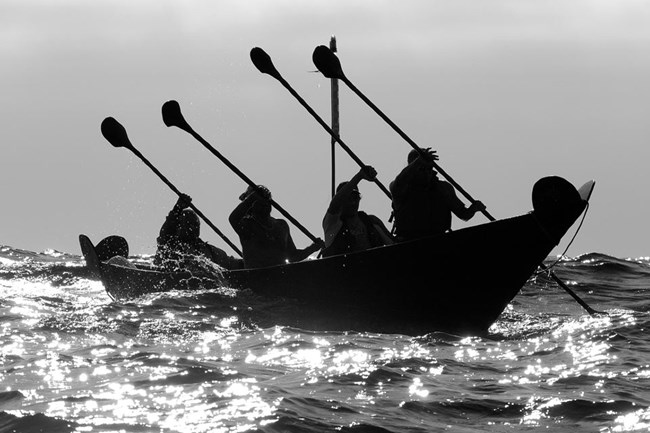
Photo courtesy Channel Islands National Park
San Miguel Island protects archeological treasures
Our Sister Park, the Channel Islands National Park off of Ventura, CA, protects some of the oldest human remains in North America. Thank you to our friend Caryl Cantrell for pointing out this fascinating article from the Ventura County Star about archeological discoveries and how they are handled in a National Park:
![]()
![]()
“Nature Notes” is a monthly short feature detailing some of the wondrous, seasonal activities taking place around us.
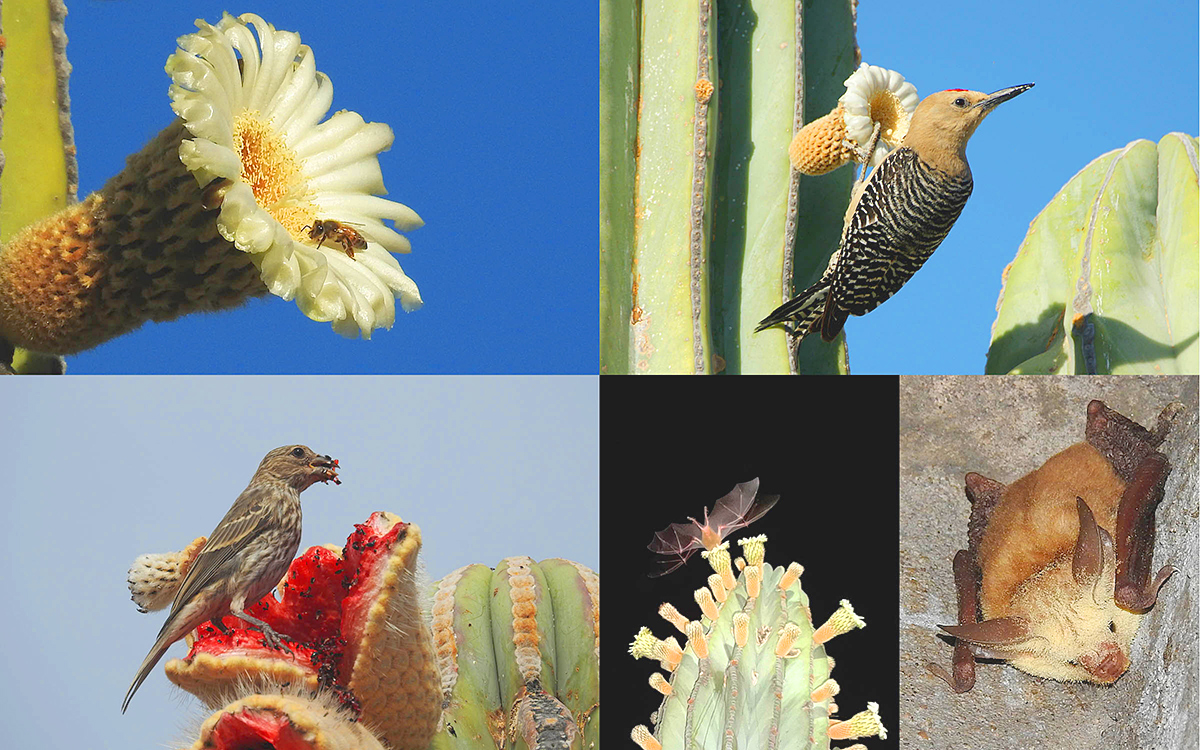
Photos courtesy of Tom Haglund/BCS Birds
Photos from top left, clockwise: Just like it’s supposed to do, a honey bee pollinates while gathering nectar in early morning.
A male Gila Woodpecker gets in on the breakfast offering.
Hovering Lesser Long-nosed Bats and well powdered Pallid Bats are prime pollinators on the night shift.
Female Housefinch reaps the rewards of all this pollinating when she raids a burst fruit for both seeds and pulp.
By Tom Haglund
The Cardón Cactus (Pachycereus pringlei) is one of the most important plants in the Loreto region. It can attain over 20 meters in height and live for hundreds of years. It provides food, nesting sites, homes, hunting perches, and other services for a grand pantheon of species. Foxes often climb up and sleep in its forks. Lots of raptors perch on those tall uprights as they scan for prey. Birds and rodents also utilize the forks as nest sites. The numbers of insects variously utilizing the Cardón is probably not even known. They, in turn often provide food for other creatures, including, of course, woodpeckers. They, in their turn, make holes pursuing insect food and also for nesting and just hangin’ out. These holes are ideal nest sites for cavity nesting species, including not just birds, but rodents, reptiles, arachnids, and on and on. Don’t stick your finger in one of those holes — for obvious reasons.
One of the most important contributions the Cardón makes is the provision of food to local fauna. It is a flowering plant that relies on pollinators for fertilization and attracts them with nectar, which they go after in various ways. The flowers, huge, waxy white, and extraordinarily beautiful, open around dark on evenings from February through May. This night blooming makes them a natural for moths and bats to pollinate. Yes, I said bats, there are two here that are very good pollinators of cacti. The Lesser Long-nosed Bat (Leptonycteris yerbabuenae) licks daintily with its long tongue while hovering and picking up some pollen, but the Pallid Bat (Antrozous pallidus) just plunges right into the open flower and emerges so covered in pollen that it is almost unrecognizable.
In the morning the plant stops producing nectar and the flower folds up dead, but not before some diurnal nectar-loving species have their shot at it. These may include dozens of species of insects and birds. Pollination accomplished, a large, juicy, seedy fruit will ripen from the remains of the flower. When the fruit is fully ripe, it will burst into a star shape offering up bright magenta, soft orange, or even white pulp filled with many tiny black seeds which continue the cycle of feeding the Cardón’s neighbors, who, in turn, will distribute the seeds, expanding their host’s range.
![]()
Enjoying Your Soundings Newsletter?
We’re proud of the work going on at Eco-Alianza, and we hope you are, too! Please “Share” this newsletter, using the icons at the bottom of the page. Thank you!
![]()
SAVE THE DATE!
Friday, November 16 – Eco-Alianza’s 11th Anniversary Gala!
Please mark your calendar!
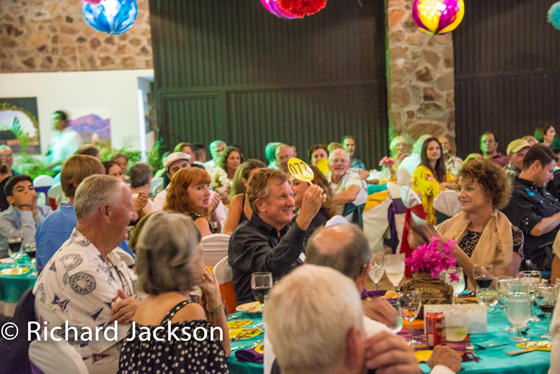
Photo courtesy of Richard Jackson
The event will feature amazing silent and live auction items but with a shorter speaker program, including a sumptuous dinner with a new twist by La Mision.
If you have a unique experience or an item you wish to donate, please contact
Edna.Peralta@ecoalianzaloreto.net .
Thank you!!!






